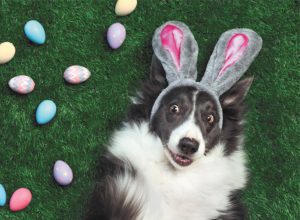

Easter Grass
Cats love anything that moves. Easter grass moves easily in a room with a breeze or draft, makes interesting sounds, and, for some cats, it is simply irresistible and must be eaten.
Stringy things like Easter grass or tinsel at Christmas, pose a deadly threat if ingested. Veterinarians consider Easter grass a linear foreign body. Signs that your pet has this problem, aside from the material being visible from the mouth or anus, are vomiting, straining to defecate, and a painful abdomen.
Trying to pull out visible grass strings is not recommended. Pulling the strand can cause more damage if the piece is long and trapped far inside the body. Call your veterinarian if you suspect that your cat has sampled the Easter grass. While linear foreign bodies are more common in cats, dogs may also ingest non-food material, and the same concerns apply here.
Chocolate
Chocolate is typically more of a dog hazard, as many dogs have a sweet tooth, a great nose, and the determination to find chocolate—hidden or not. More often than not, your dog will find Reese’s Peanut Butter Cups or Hershey’s Kisses in eggs hidden in your backyard Easter hunt before your kids, so, keep them away.
The toxic components in chocolate are theobromine and caffeine, and the level of toxicity is based on the type and quantity of chocolate consumed as well as the size of your pet.
Different types of chocolate have different amounts of theobromine and caffeine; dark chocolate contains the highest concentrations and white “chocolate” contains the least. Early clinical signs are vomiting, diarrhea, and trembling.
The toxicity level for either a dog or cat is the same depending on weight, however, dogs are more so in danger than cats since dogs are drawn to sweets meanwhile cats are not. A cat may try some chocolate but is less likely to continue eating it.
Xylitol
If you’re baking a cake for Easter beware of xylitol. It’s an artificial sweetener used in home baking and found in many products including some sugar-free gums and diet foods. It can also be found in some Easter eggs. Dogs are extremely sensitive to xylitol and even small amounts can cause toxicity. Early symptoms of xylitol poisoning include lethargy, vomiting and loss of coordination. Seizures and even death may occur. Assistance dog Ginny made a remarkable recovery after eating a toxic amount of xylitol.
Spring flowers and plants
Spring flowers and plants can be found in many homes and gardens around Easter. Unfortunately, several are poisonous to dogs, with the bulbs posing the biggest risk. Daffodil, lily and spring crocus bulbs are all highly toxic. Symptoms of plant or bulb poisoning can include vomiting, upset stomach and heart and kidney problems.
Contact Animal Oasis Veterinary Hospital to schedule a wellness exam, vaccinations, and calming medications for your pets today!
Animal Oasis Veterinary Hospital in Naples offers the most up to date and progressive veterinary services for your pets. Ranging from laser surgery, ultrasound, dental X-rays, radiology, full pharmacy, and in house diagnostics, Animal Oasis Veterinary Hospital provides your pets with the necessary options for treatment.
239-431-9667
www.aovethospital.com
 Southwest Florida's Health and Wellness Magazine Health and Wellness Articles
Southwest Florida's Health and Wellness Magazine Health and Wellness Articles

